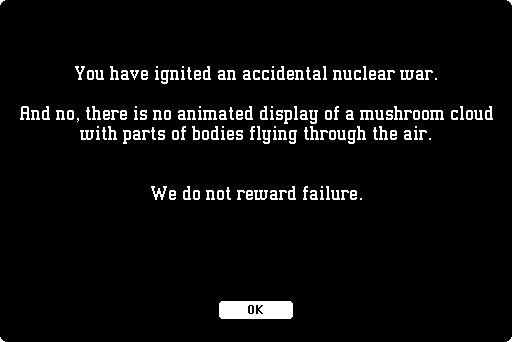
the forty-second book in the visitor recommendation series;
suggested by Robb Sherwin
The screenshot above is from Balance of Power, a computer game that I imprinted on back in the 1980s. In the game, you control either the USA or USSR during the height of the Cold War, which in the game means 1986 to 1994. (Oops.) You look over a world map of 62 countries, sending military aid here and intervening with troops there, trying to stabilize friendly regimes and topple unfriendly ones. To prevent your rival superpower from doing whatever it pleases—and to prevent you from doing whatever you please—the game allows either superpower to challenge the other’s moves. If the challenged power doesn’t back down, the impasse launches a diplomatic crisis, with prestige points at stake, and ultimately a military crisis, steadily escalating from DEFCON 5 up to (if neither side blinks) DEFCON 1, at which point the nukes start flying and everyone loses. However, if tensions are sufficiently high, a nuclear holocaust can be set off at DEFCON 2 or even DEFCON 3, accidentally. How likely that would have been is one of the things this book is about. Spoiler: it would have been extremely likely.
A few years ago I listed to a couple of audiobooks about the development of nuclear power, with a heavy focus on accidents. Robb Sherwin suggested that I follow up with this one, and while it seemed like it would be more of the same, I just did two drives of 12+ hours apiece, and listening to a long audiobook seemed like a better idea than just listening to Poppy’s new EP on repeat. There is some overlap (e.g., the Manhattan Project, again), but for the most part the focus is different. Or perhaps I should say foci, since Command and Control is basically three different books that happen to have been shuffled together. One is about the evolution of the USA’s nuclear strategy as it went through phases of being grounded in different philosophies: massive retaliation, flexible response, minimal deterrence, etc., etc. One is a long account of the circumstances leading up to and the aftermath of a Titan II missile explosion in Arkansas in 1980. And one is about accidents involving nuclear weapons more generally. I said of Atomic Accidents that while the author was mainly concerned with mishaps at nuclear power plants, he also covered “military accidents: planes that crashed while carrying armed nuclear missiles, that sort of thing.” What the author of Command and Control discovered is that you can’t just cover two or three accidents and say, wow, we’ve had a few close calls—he filed a Freedom of Information Act request for information about accidents involving nuclear weapons over just a ten-year period, and what came back were accounts of hundreds upon hundreds upon hundreds of them, shocking even the experts he was relying on for the bulk of his research. One of the plot threads in my webcomic, which I will probably never get to at this point, is that the professor of transdimensional physics, Richard Russell, was actually from another dimension himself—“dimensions” here being, essentially, alternate realities with different histories. He’d had to flee his own dimension and eventually settled into the one in which the webcomic takes place. But that wasn’t the first one he’d visited. It was the fiftieth. The problem was that the first forty-nine were all radioactive wastelands. Because the probability of getting through the Cold War without life on earth getting annihilated, it turned out, was startlingly low. Command and Control suggests that this premise is not just a flight of sci-fi fancy.
 |
 |
 |
 |
||
|---|---|---|---|---|---|
Tumblr |
this site |
Calendar page |
|||
